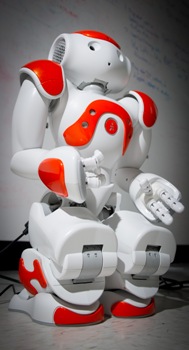Apr 2 2013
A dancing robot is nothing new. A quick search on YouTube will yield videos of robots dancing to Michael Jackson’s Thriller, Gangnam Style, the Macarena and more.
 LaViers uses a humanoid robot, the Aldebaran Robotics's Nao, in her research and performance.
LaViers uses a humanoid robot, the Aldebaran Robotics's Nao, in her research and performance.
But at the Georgia Institute of Technology, researchers are taking robots and dance to a higher level.
Instead of programming a robot to copy an existing dance such as those in the online videos, Amy LaViers, a Ph.D. candidate in electrical and computer engineering, is defining the various styles of human movement and creating algorithms to reproduce them on a humanoid robot.
What’s more, LaViers has produced a robotic dance performance based on her research, called “Automaton,” in which a Nao robot and professional dancers explore the notion of “automatic style.”
The show debuts at 8 p.m. on April 6 in the lower atrium of the G. Wayne Clough Undergraduate Learning Commons. A second showing will be held at 5 p.m. on April 13, also in Clough Commons’ lower atrium, as part of the 2013 TechArts Festival.
“We are working with such a highly articulated robot that can do so many cool things, yet there are many ways he is limited too,” LaViers said. “I do play with that idea of: What can the robot do, and what can the people do? Where are the differences and where are the similarities?”
LaViers' work exemplifies the intersection of engineering and dance, and could be applied to make robots more useful in everyday life, said Magnus Egerstedt, professor of electrical and computer engineering and LaViers' faculty advisor.
“When robots are transitioning out of the manufacturing floor and into homes, becoming co-workers instead of tools, they need to understand to a certain degree what it means to be human,” Egerstedt said. “They need to move in a style that makes sense to people, so that’s why we started thinking about how you quantify style.”
A dancer for most of her life, LaViers thought to combine dance with engineering during her undergraduate senior project at Princeton University. She saw a natural overlap between choreography, an arrangement of steps, and robotic algorithms, an engineering tool that plans robotic movement.
Robotic movements tend to be exact and jerky in motion, but LaViers believes robots could have a range of quality of movement. To achieve this, she is developing quantitative tools that explain what differentiates movements using dance theorist Rudolf Laban’s notion of quality.
LaViers also examines the basic poses and movements that define a style to quantify differences between genres of movement. What is the difference, for instance, between doing a disco dance and performing ballet? Using a computer program she developed for her thesis, she encodes that information so it can be reproduced on robots.
“Understanding how humans move is key to developing better techniques and applications to make robots move in a way that humans can relate to. ‘Style’ is part of this – particularly in the arts,” LaViers said.
LaViers’ research fits into the overall objective of Egerstedt’s lab, the Georgia Robotics and Intelligent Systems (GRITS) lab. The lab aims to produce robotic algorithms that endow robots of all kinds with desirable behavior.
Having algorithms that mimic human movement in a high-level way could advance the use of robots in real-world settings. For example, it may enable caregiving robots to have more comforting movement that is less intimidating to patients. Style-based measurements may also provide better feedback to patients recovering from physical disabilities or injuries.
In the “Automaton” piece, LaViers presents choreography generated from the framework in her thesis that is performed by human dancers and automated on the humanoid robot. After the performance, audience members will have a chance to give feedback on their impressions of the movement.
“I hope the audience thinks of movement and programmed objects a little bit differently after seeing the show,” LaViers said. “I also hope it brings up ideas of technology in our lives today and in the future, when robots may be more commonplace.”